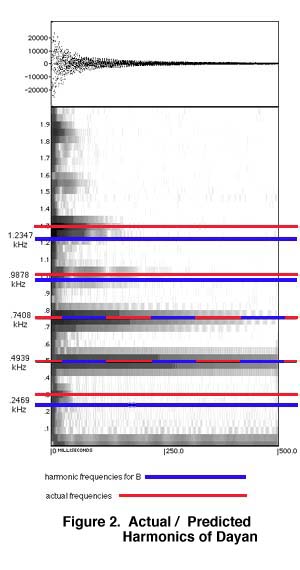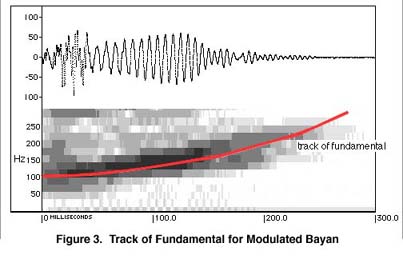Note – This piece was originally published in the “Journal of Sangeet Research Academy”, Calcutta, India, Vol.13, No 1, October 1999
Introduction
There has been a fair amount written about the acoustics of tabla. However, as laudable as such works are, they really do not address the issue from the standpoint of the practicing musician. There are psychoacoustic issues which are of great importance to the listener, student and the practitioner of the art of tabla. It is the purpose of this article to make a brief survey of some of these issues.
Background
The sounds of most drums are characterized by strongly inharmonic spectra; however tablas, especially the dayan are an exception. This was pointed out as early as 1920 by C. V. Raman and S. Kumar (Raman & Kumar 1920). This was further refined in a later paper (Raman 1935). From that time it has been a simple question of further refinement. Such refinement has been done by numerous other investigators (e.g., Bannerjee 1989, Rossing 1992). The classical model put forth by Raman is very neat. It represents the sound of Indian drums, like the tabla–dayan, as having a spectrum consisting of five harmonics; these are the fundamental with its four overtones.
However closer examination of the spectra of the tabla shows that Raman’s model is just an approximation. We see numerous points that deviate significantly from Raman’s simple model which have tremendous practical, artistic, and psychological implications.
| IF YOU ARE INTERESTED IN TABLA, THIS BOOK IS FOR YOU |
|---|
This is the second volume of the most complete series on the tabla. Advanced Theory of Tabla It is available around the world. Check your local Amazon for pricing. |
Experimental Setup
The experimental setup was simple. A tabla of known good quality was tuned to an appropriate note. Experimentation showed that a stroke called “Ra” (e.g. Gin – TaRa – Na) produced the maximum number of harmonics. A Nakamichi CPM100 with a super-omnidirectional capsule was used as a transducer. The data was gathered at standard CD parameters (i.e. 16 bit data sampled at 44.1kHz). This data was then sampled and process with a modified Macintosh 7600 by Apple. The modifications include; increasing the RAM to 160MB, addition of a 7200rpm fast/wide AV drive, and the addition of a Jackhammer fast/wide SCSI accelerator. The data was processed with Sound Edit 16 to affect the Fourier transform and chart the data. The final data was printed with an HP4ML laser printer by Hewlett-Packard. (Go to Introduction to Spectrum Analysis for a basic introduction.)
Overview Of Harmonic Structure of the Dayan
An example of the harmonic structure is shown in figure 1. We see Raman’s five harmonics quite clearly; additionally we see four other overtones which were not mentioned. Raman was dealing with very primitive equipment so it is not surprising that he missed these other spectral components. It is probable that only the first seven harmonics are musically significant.

At first glance the spectrum as measured by our modern equipment is close to the model laid down by Raman. However upon close examination of the numbers, we find that they do not add up correctly. This is illustrated in the spectrogram of “Taa” shown in figure 2. The harmonic spectrum by definition, is characterized by an integral relationship between the overtones and the fundamental. This clearly is not the case because many of the measured frequencies are very different from the theoretically predicted values as laid down in Raman’s simple model.

It is not our goal to cast aspersions on the fine work of Raman; membraneous percussive instruments are notable in their strong inharmonic character. It is amazing that the tabla comes as close to being a harmonic spectrum as it does. Our purpose is to acknowledge the existence of these inharmonic characteristics and examine the psychoacoustic and practical ramifications thereof.
Psychoacoustic and Practical Considerations
There are numerous practical implications of the inharmonic characteristics of the tabla-dayan. The most basic is the common technique of muting the fundamental with the last two fingers of the hand. If this lowest vibrational mode were not muted it would introduce the major second (shuddha rishabh) which musically is inappropriate in a large number of rags. Furthermore the major second (shuddha rishabh) droning on continuously with the tonic (Shaddaj) is extremely unpleasant due to the strong dissonance of this relationship.
This brings up one extremely interesting point. Common strokes such as “Taa“, “Tin“, and “Naa” are strongly pitched resonant strokes (i.e., khula) yet the fundamental is suppressed by the last two fingers. This means that the strong second and third harmonic force the brain to extrapolate downward and assign a pitch to a nonexistent fundamental. The position that the brain assigns is substantially lower than any frequency that the tabla is able to produce. Therefore we are hearing the frequency of a nonexistent vibration!
The Bayan
The tabla-dayan is not the only drum with a pitch: the bayan also has a pitch. The well know performer Zakir Hussain commonly plays melodies on the bayan simply by the pressure of the hand and the position of the wrist. Figure 3 shows the sound of “Ga” played with the wrist sliding forward and the pressure increasing, this is a very common modulation. The relationship between the spectra of the bayan and the perceived sound is easy to understand. We do not have to delve into obscure areas of psychoacoustics in order to understand why it sounds the way it does.

Conclusion
Examining the harmonic spectra of the tabla-dayan reminds us of the proverbial dancing bear in the circus. It is not a question that the bear dances badly, it is remarkable that it dances at all. In the same manner it is not a question that the spectra exhibits inharmonic characteristics. It is amazing that it has the harmonic quality that it does. This sometimes harmonic, yet sometimes inharmonic quality, has had tremendous practical impact on the performance aspect of the tabla. This is shown in the fact that the perceived pitch of the tabla corresponds to a completely nonexistent frequency. This is also shown in the avoidance of strokes which show the lowest vibrational frequency (e.g. Tun).
If complex psychoacoustics characterizes the tabla-dayan; then simplicity characterizes the psychoacoustics of the bayan. There are very few overtones and the perceived pitch tracks the change in frequency without any conceptual complications.
Works Cited
Banerjee, B.M. & Dipali Nag
1989 “A Comparison of Acoustic Characters of Sounds from Indian Drums”, Journal of the Acoustical Society of India. Vol. 17, No. 3&4, Pg. 295-298.
Banerjee, B.M.
1989 “Research on Musical Acoustics in Sangeet Research Academy”, Journal of the Acoustical Society of India. Vol. 17, No. 3&4, Pg. 25-30.
Raman, C.V.
1934 “The Indian Musical Drums”, Proc. Indian Acad. of Science. Vol 1A, pg. 179-188
Raman, C.V. and S. Kumar
1920 “Musical Drum with Harmonic Overtones”, Nature. Vol 500, pg. 104.
Rossing, Thomas D.
1992 “Acoustics of Drums”, Physics Today. Woodbury, NY: American Institute of Physics. March 1992.
